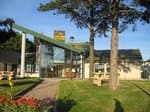The three Valleys
In the middle of a red soil and wooded glen landscape, a whole architectural and industrial heritage awaits you: the castle of Saint-Izaire, an ancient sand pit, a former railway line and the hamlet of Janolles with its 16th century buildings. A hike located at the confluence of the Dourdou, Gos and Tarn rivers and during which times are intertwined.
1 point of interest
 History and heritage
History and heritageVillage of Saint-Izaire
The history of this village is intertwined with that of the old Episcopalian castle, which was formerly the Bishop of Vabres summer palace. The name of the village was first made mention of in an official document dating back to 862 AD.
During the 12th century, continual invasions, acts of banditry and battles between feudal lords created a tremendous insecurity. This led to the building of battlements to improve the defensive system and providea safe haven to the neighbouring people during periods of turmoil. The castle and the fortified village date back to the time of the Vabres bishops who made the village their summer residence and a safe refuge.
When the religious wars were over and peace restored, the protective wall lost its primary function and so today the façade of the castle has windows inserted along its length. The fortified gates were also demolished to allow the passage of carts or to expand the neighbouring houses. The villagestreet, footpath and house pattern has remained unchanged since the Middle Ages, and the beautiful 15th century facades and windowscan still be seen in some streets today. The old church part of the battlements had its vault lowered in 1635 to provide housing to the schoolmaster and guards. In 1650 repair works were started by the Consuls.
Description
- Take the road towards Faveyrolles up to the first intersection, then fork to the right on a dirt road for 800 m (scenic view over the village). Reach the disused "Le Graudenc" farm building, carry on towards the culminating point at the foot of a high-voltage tower, then walk down the Gos creek valley and enjoy an extensive scenic view over the distant horizon.
- After a steep slope between two fields, fork to the left at the intersection right by the small stone cross. Walk past dilapidated buildings and follow the track down to the valley. On the valley bottom, right at the intersection, take a hairpin bend to the right above the sandpit which can be seen 50 m further.
- Walk along the shady bank of the Tarn river and through the hamlet of Les Alverhnes. After a 300 m section of tarmac road, go down to the left and pass under the stone bridge of the former railway.
- Go to the left of the tunnel along the Dourdou river and carry straight on, leaving to the left a nice private bridge over the Dourdou river next to the hamlet of Janolles. Follow the river and pass under another bridge of the former railway, then get back to the tarmac road.
- Take to the left towards the Mas de Gascuel. Walk along the farm and take the gently sloping dirt road that leads you back to the village of Saint-Izaire.
- Departure : Village square in Saint-Izaire
- Arrival : Village square in Saint-Izaire
- Towns crossed : Saint-Izaire
Altimetric profile
Recommandations
Box tree months are active from May to October. During the caterpillar phase, they feed on the leaves of box trees. They crawl down trees and move on long silken threads, although these threads are annoying when hiking they do not pose any health risk
Information desks
Avenue de Lauras, 12250 Roquefort/Soulzon
Situated in the Grands Causses Regional Natural Park, the cheese village of Roquefort stretches on the hillside over the famous scree of the Combalou Rock, in southern Larzac. The village is at an elevation of 630 m and has 700 inhabitants.
OPENING PERIODS:
The Tourist Office is open all year round:
- In July and August, Monday to Saturday: 9.30 to 18.30, Sunday: 10.00 to 17.00.
- April, May, June, September, October; Monday to Saturday: 9.30 to 12.15 & 13.00 to 17.30, closed on Sunday.
- January, February, November, December; Monday to Friday: 9.30 to 12.15 & 13.00 to 17.00, closed on Saturday and Sunday.
Transport
Travel by bus or train: https://lio.laregion.fr/
Carpooling : BlaBlaCar, Rézo Pouce, Mobicoop, Idvroom, LaRoueVerte, Roulez malin
Access and parking
Parking :
Source

Report a problem or an error
If you have found an error on this page or if you have noticed any problems during your hike, please report them to us here:

